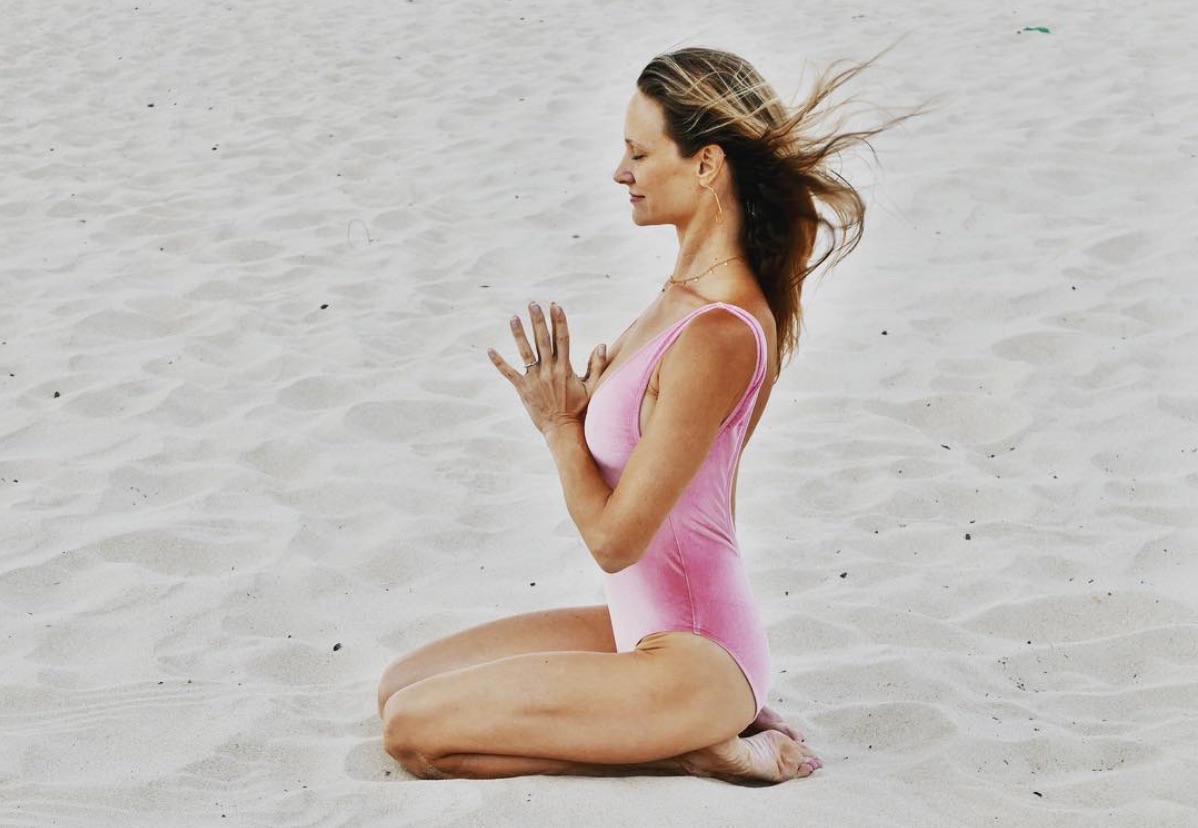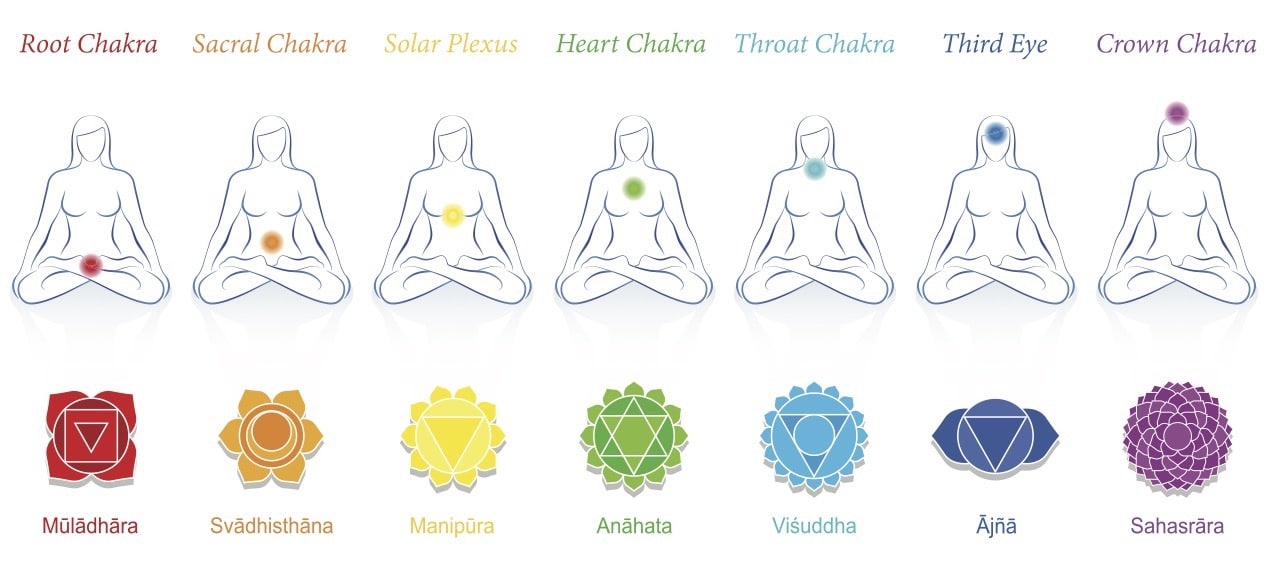 Live Consciously
Live Consciously  Mindfulness & Meditation
Mindfulness & Meditation
A Simple Guide to the 7 Chakras and How to Balance Yours
By Emma StessmanHome » Live Consciously » A Simple Guide to the 7 Chakras and How to Balance Yours
Chances are you’ve heard the term “chakras” thrown around in a yoga class.
In Sanskrit, the word translates literally to “wheel.” Think of each chakra as a ball of energy, each one located in a different part of the body. Yoga teacher Sarah Platt-Finger, co-founder of New York City’s ISHTA Yoga and the private yoga teacher of Dr. Deepak Chopra, describes each chakra as the headquarters of a different element in the body. “The elements all exist within us,” she says, “and they also have different qualities that are reflected through our emotions and our personality.”
Seven chakras span our frames, starting at the base of our tailbone and extending up to the top of our head. Each one comes with a different color and ancient element (e.g. earth, air, fire), as well as physical and psychological characteristics. Yogic philosophy dictates that you can be excessive or deficient in each one, and imbalances manifest themselves in different ways.
When your chakras are all balanced, according to this ancient belief system, you’ll live a happier and healthier life. Of course, this is all philosophy, not to be confused with any sort of modern scientific understanding. In case this philosophy calls to you, we present Platt-Finger’s explanation of how to apply it to your life.
 (Photo: Instagram/@splattfinger)
(Photo: Instagram/@splattfinger)
The 7 Chakras and How to Balance Them
1. The Root Chakra
Element: Earth
Color: Red
The first chakra, muladhara, is all about physical and emotional survival needs and our sense of stability and groundedness, Platt-Finger says. It exists at the base of the spine (hence the name) and is connected to the earth element.
Excessive: feelings of greed, stubbornness, and heaviness (both physical and emotional)
Deficient: flighty and disconnected from your physical needs
How to balance: Use meditation to establish a sense of groundedness.
RELATED: Set a Daily Intention with this Morning Yoga Practice
2. Sacral or Pelvic Chakra
Element: Water
Color: Orange
The sacral chakra, svadhishthana, is all about the flow of creativity and passion. Associated with water, “this chakra deals with our attachments and our aversions, and our likes and dislikes,” Platt-Finger says. As you can probably guess from its location in the pelvic region, it’s also linked to sensuality and sexuality.
Excessive: hyper-sexual, easily giving into temptation
Deficient: an inability to experience pleasure
How to balance: Maintain a healthy sex life and respect your body.
3. Solar Plexus Chakra
Element: Fire
Color: Yellow
Also called manipura, “the third chakra is a lot about transformation,” Platt-Finger explains. “It’s how we’re not only able to metabolize our food, but metabolize our thoughts and our emotions so that we have this sense of individuality and independence in the world.” Located just above the navel and represented by the element of fire, when the third chakra is in balance, you’ll have a strong sense of autonomy, self-esteem and the ability to persevere.
Excessive: feelings of hot-headedness and arrogance
Deficient: timidity and shyness
How to balance: Try yoga asanas like boat pose and warrior poses, and focus on healthy digestion.

4. Heart Chakra
Element: Air
Color: Green
Associated with the element of air, anahata serves as a sort of bridge between the lower and upper chakras. It’s all about harmony and balance! As its location (in the chest) and name suggest, the heart chakra deals with many emotions—including love for both ourselves and others, Platt-Finger says.
Excessive: overly concerned about others, but not in a good way
Deficient: lack of emotion or compassion
How to balance: Try heart-opening yoga poses; add a mantra into your meditation, with the sound “yum,” which correlates with the fourth chakra.
RELATED: 6 Ways to Conquer Fear for More Happiness and Success
5. Throat Chakra
Element: Sound or Space
Color: Blue
The fifth chakra, vishuddha, controls how we communicate. When it’s in balance, we’re able to speak our own truths and actively listen to those of others, Platt-Finger says. In the body, this chakra is associated with the cervical spine, neck and throat regions.
Excessive: overly talkative and unable to be in silence
Deficient: unable to effectively communicate or express yourself
How to balance: Practice active listening strategies. Use affirmations to establish what you want to say before you communicate.
6. Third Eye Chakra
Element: Light
Color: Indigo
In Sanskrit, the sixth chakra’s name translates to “command,” so it’s no wonder that it’s associated with the pituitary gland, also known as your body’s “master gland.” Intuition, imagination and your personal perceptions of the outside world are all governed by ajna, the third-eye chakra, Platt-Finger explains.
Excessive: distorted perceptions
Deficient: unable to see things in a new way
How to balance: This chakra is best balanced by meditation and breathing techniques.
7. Crown Chakra
Element: Cosmic Energy/Divine Consciousness
Color: Purple
The seventh and final chakra, sahasrara is located at the top of the head. Platt-Finger describes this chakra as “what enables us to connect to all things—in particular, to a realm … not really in the physical world, but in this more cosmic realm.” (Woah, heady!) Essentially, the crown chakra is what allows you to connect to your spirituality, to something deeper than just yourself.
Excessive: a feeling of disconnect from the material world
Deficient: lacking in faith or spirituality
How to balance: Learn to embrace silence and practice meditative breathing techniques and inversions.
(Image: Edit Sztazics via Unsplash)
Emma Stessman is a New York-based writer. She is an editorial assistant for Shop TODAY, a social media enthusiast, and expert popcorn maker.
DISCOVER MORE
RECENT ARTICLES

Want a sneak peek inside the program?
Get FREE access to some of the core training materials that make up our signature program – Become a Nutrition Coach.
Get Access












































































































































































































































































































































































































































































































































































































































































































































































































































































































































































































































































































































































































































































































































































































































